iPhone 14 vs iPhone 11: Should you upgrade?
How much better is Apple's current iPhone?
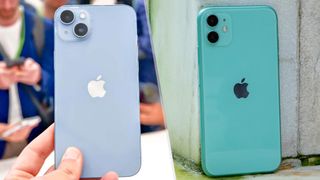
An iPhone 14 vs iPhone 11 might not seem particularly relevant right now, given the three year gap between release. But a lot of people are sticking with the same phone for longer, and the iPhone 11 is still a very serviceable phone. But things have changed, and it pays to know what you may, or may not, be missing out on.
Three years is a long time in tech terms, and the iPhone 14 has a number of improvements than its elder sibling. Apple's processors are faster, cameras are better, and newer models come with 5G. But are those improvements worth spending $799 on a brand new phone?
Those are questions we can answer. Not only have we run a number of tests for our iPhone 14 review, we still have older iPhone 11 models on hand. That allows us to do side-by-side comparisons to see what how big the advances Apple has made since the iPhone 11's 2019 debut.
For the purposes of this iPhone 14 vs. iPhone 11 comparison, we're going to mostly talk about the the base models. If you want to see what addition features the larger iPhone 14 Plus or the Pro models deliver, our iPhone 14 vs. iPhone 14 Plus and iPhone 14 vs. iPhone 14 Pro face-offs go into greater detail.
iPhone 14 vs. iPhone 11: Specs
| Row 0 - Cell 0 | iPhone 14 | iPhone 11 |
| Screen size | 6.1-inch OLED (2352 x 1170) | 6.1-inch LCD (1792x828) |
| CPU | A15 Bionic | A13 Bionic |
| RAM | 6GB | 4GB |
| Storage | 128GB, 256GB, 512GB | 64GB, 128GB, 256GB |
| Rear cameras | 12MP wide (f/1.5), 12MP ultrawide (f/2.4) | 12MP wide (f/1.8), 12MP ultrawide (f/2.4) |
| Front camera | 12MP (f/1.9) | 12MP (f/2.2) |
| Battery size | 3,279 mAh | 3,110 mAh |
| Battery life (Hrs:Mins) | 9:28 | 11:16 |
| Size | 5.8 x 2.8 x 0.31 inches | 5.9 x 3 x 0.33 inches |
| Weight | 6.1 ounces | 6.8 ounces |
| Colors | Midnight, Purple, Starlight, Product red, Blue | Black, Green, Yellow, Purple, White, Product Red |
iPhone 14 vs. iPhone 11: Price and availability
The iPhone 11 cost $699 when it debuted, with Apple subsequently cutting the price after the launches of the iPhone 12 and iPhone 13. The iPhone 11 had dropped to as little as $499, but with the arrival of the iPhone 14, Apple finally killed the older model from its lineup.
You'll pay a bit more to upgrade to the iPhone 14 than you did when the iPhone 11 was on sale. These days, Apple's phones start at $799, though the iPhone 14 comes with 128GB of storage in its base mode. The entry-level iPhone 11 featured a cramped 64GB.
You can probably save on the cost of a new phone with one of the best iPhone 14 deals or by trading in your iPhone 11 when you upgrade. Apple will give you up to $200 back when you trade-in an iPhone 11 with your iPhone 14 purchase. (The iPhone 11 Pro and iPhone 11 Pro Max qualify for maximum trade-ins of $230 and $280, respectively.)
iPhone 14 vs. iPhone 11: Design
Apple has made some design changes since the iPhone 11's 2019 release. Those were the last phones from Apple to offer curved edges, as Apple moved to a flat-edge design with the iPhone 12 and hasn't looked back. That's a controversial switch for some, though, personally, I find flat edges easier to grip than slippery curved sides.
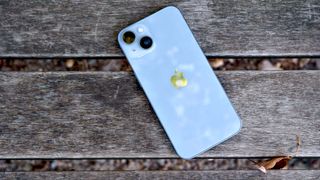
You're getting a more durable phone when you upgrade to the iPhone 14 from the iPhone 11. Apple started using Ceramic Shield material with the iPhone 12, and that's made subsequent devices less prone to damage from drops. Like the iPhone 11, the iPhone 14 has an IP68 water resistance, but these days, the more modern phone can survive a dunk in up to 6 meters of water. The iPhone 11's water resistance is only good for 2 meters.
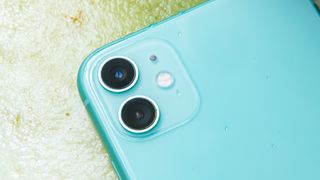
The notch remains on the iPhone 14, though it's smaller than the one found on the iPhone 11. Upgrade to an iPhone 14 Pro model, and the notch goes away entirely, replaced by Apple's Dynamic Island feature.
I find the colors on the iPhone 11 brighter and more inviting. Apple has gradually gone with more muted hues, making the colors appear lighter on the newer phones. The iPhone 14's rear camera array features diagonal lenses, and it juts out a little more than iPhone 11's vertically stacked cameras did.
iPhone 14 vs. iPhone 11: Display
While camera and processor improvements will get the most attention, don't forget how much has changed with displays in the three years since the iPhone 11 has come out. While both phones feature 6.1-inch panels, that's about where the similarities end.
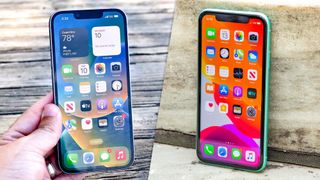
The iPhone 11 still uses an LCD panel, while Apple's flagship phones shifted entirely to OLED with the iPhone 12. The Super Retina XDR screen on the iPhone 14 offers sharper resolution and promises a peak brightness of 1,200 nits. The iPhone 11 hit 652 nits in our testing while we measured the iPhone 14 at 757 nits on a light meter.
While the iPhone 11 matches up pretty well against the iPhone 14 in the amount of color it can display — though the OLED panel on the iPhone 14 is better at reproducing blacks — the brightness and sharpness of the newer phone's screen will make a world of difference.
iPhone 14 vs. iPhone 11: Cameras
While you've been holding onto your iPhone 11 for the last couple of years, Apple's been making some changes to the cameras on its phone. The megapixel ratings haven't really changed on the rear cameras — you still get a 12MP main camera and and a 12MP ultrawide lens — but just about everything else has.
The main camera sensor on the iPhone 14 is bigger and the aperture has gotten wider — f/1.5 on the iPhone 14 versus f/1.8 on the iPhone 11. The end result is that the newer iPhone lets in more light which helps capture better photos in low-light situations. Over the years, Apple also adopted a 7-element lens for its main camera, which improves the accuracy of images. The ultrawide camera captures more of the scene as well.
For my camera comparisons, I took photos with both an iPhone 14 and an iPhone 11 Pro Max. That may not seem like an even comparison — the iPhone 11 Pro Max has a telephoto lens, which is MIA on the standard iPhone — but I think it helps illustrate just how mobile photography has advanced in the last three years. The iPhone 11 Pro Max topped the list of best camera phones in its day, so seeing how it performs against the iPhone 14 should be eye-opening.
You can see a difference right away in this photo of a pumpkin display at my local farmer's market. Focus on that big pumpkin at the center of the display — the iPhone 14 reproduces a more balanced and natural color that also highlights the textures of the gourd. Perhaps that's the work of the iPhone 14's Photonic Engine, a new computational photography feature that optimizes texture and other details while heightening the color, especially in low to mid-light settings.
Moving under a canopy into less favorable light, you also see how changes over the years to the iPhone's cameras benefit the iPhone 14. Both iPhones produced excellent shots of the tomatoes in the foreground of the picture. But the iPhone 11 Pro Max's stab at the cactus pears and kumquats in the background are more subdued. These fruits appear more vibrant in the iPhone 14's photo.
This shot of a plate of tacos was captured under less-than-ideal conditions, with a high-chance of backlighting due to the sun streaming in through the taqueria's window. I'm actually impressed with how the iPhone 11 Pro Max handled those conditions keeping everything in focus. That said, the tacos look a little sharper in the iPhone 14's shot, and the writing on the Coke bottle is more legible. I also think the tiling by the window is more balanced and less glossy in the iPhone 14's photo.
Sticking with some challenging lighting indoors, this shot of some Halloween decorations really shows off the iPhone 14's skill in low light. The iPhone 11 Pro Max shot is harsh and the white balance is off. The iPhone 14 Pro Max has managed to call out details on the bird skeleton, but at the expense of everything else in the photo. The iPhone 14's image is better balanced, and you get more detail from the little white pumpkins.
Something odd happened with an outdoor shot at night featuring some more Halloween decorations. The iPhone 14's tendency to capture more light isn't serving it well here, as it lets the light from the porch above stream in and wash out some of the shot.
That background lighting isn't in evidence in the iPhone 11 Pro Max's effort. Still, even with the excess light, the iPhone 14 calls out more details — look at the sharp focus on the bejeweled pumpkin on the right side of the shot. The color of the skeletons is more accurate in the iPhone 14 photo, too, as the iPhone 11 Pro Max pumps up their whiteness.
Because of the way we crop these photo comparisons, you can't really see that the iPhone 14 captures more of the foreground in this shot utilizing the two phones' ultrawide cameras, but trust me it does. As for what you can see, the text on the banner above this pumpkin display is more readable in the iPhone 14's photo and the colors more natural than what the iPhone 11 Pro Max reproduces. That said, the older iPhone doesn't wash out the sky as much as the iPhone 14 does on the right side of the shot.
Just for kicks, I tried out the zooming capabilities on both phones, even if it meant using a digital zoom on the iPhone 14. At 2x, the lack of a telephoto lens doesn't seem to hurt the iPhone 14. There's less of a haze in its shot, and the theater marquee looks sharper. I also like the way the iPhone 14 calls out the carvings in the facade of the movie theater, which look more muted in the iPhone 11 Pro Max shot.
The iPhone 14 sees the first change to Apple's TrueDepth camera in years. The front camera still uses a 12MP sensor, but the aperture is wider at f/1.9. (The iPhone 11 has an f/2.2 aperture.) Apple added autofocus to the iPhone 14's front camera as well.
Neither change is really in evidence with the self-portrait I took, where the iPhone 14 and iPhone 11 Pro Max produce evenly matched shots. I do think my skin tone looks more natural in the iPhone 14's effort, but it's a subtle difference.
Upgrading to the iPhone 14 from the iPhone 11 also lets you take advantage of the various video features Apple has added to its phones over the years. Cinematic Mode, for example, lets you shift focus while capturing video, with a stylish blur appearing in the background or foreground, depending on what you want to focus on. That's not something the iPhone 11 can support.
iPhone 14 video clip
iPhone 11 Pro Max video clip
The iPhone 14 also introduces Action mode, which promises better stabilization when you're shooting video. To my eye, the iPhone 14 video seems a little bit smoother as I move the camera around a fountain, whereas the iPhone 11 Pro Max has some perceptible jerkiness as I move from side to side. I imagine the effect would be more pronounced in an action shot where either the subject or the cameraperson — or both! — were moving more rapidly.
The bottom line here is that the iPhone 11 is still capable of taking great photos, especially if you've paid up for the iPhone 11 Pro Max. But there's very definite improvements by turning to the iPhone 14 and its more advanced hardware and software.
iPhone 14 vs. iPhone 11: Performance
One other area where there's a clear benfit to upgrading centers around the performance of the iPhone. The A13 Bionic inside the iPhone 11 was the top-performing silicon in its day, and it can still compare favorably to some Android phones. But the A15 Bionic that powers the iPhone 14 is a more advanced chip, particularly when it comes to graphics thanks to an extra core in the A15's GPU.

In Geekbench 5, which measures overall CPU performance, the iPhone 11 posted still-respectable single and multi-core scores of 1,333 and 3,251, respectively. But the iPhone 14 bests those numbers with its own results of 1,727 and 4,553. That's a performance gain of 30% to 40%.
Back when we tested the iPhone 11 in 2019, we hadn't yet switched to 3DMark's Wild Life Unlimited test to measure graphics. But I ran the benchmark on the iPhone 11 Pro Max I had on hand, and came up with a result of 48 frames per second. The iPhone 14 tops that with a 69-fps result.
In our real-world test where we transcode a video using Adobe Premiere Rush, the iPhone 11 completed the task in 45 seconds. The iPhone 14 needed just 28 seconds to transcode the same video clip.
To put this another way, if you've been happy with how your iPhone 11 performs, you're going to be happier with the iPhone 14, particularly when it comes to graphically-intensive tasks.
iPhone 14 vs. iPhone 11: Battery life and charging
Frankly, we're puzzled by how the iPhone 14 (and the iPhone 14 Pro alongside it) performed on our battery test, in which we have phones surf the web continuously over cellular until they run out of power. The iPhone 14 averaged a time of 9 hours and 28 minutes, which is roughly 30 minutes less than the average smartphone. It's also well off the 11 hour, 16 minute result we got from the iPhone 11 three years ago.
The iPhone 14 Plus and iPhone 14 Pro Max don't exhibit any such problems, riding their bigger batteries to spots on our best phone battery life list. You could blame the addition of 5G, which the iPhone 11 lacks, but that wouldn't explain why the larger iPhone 14 models preformed substantially better in our test.
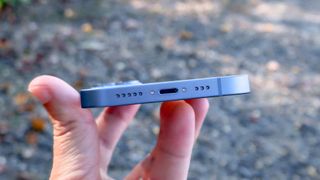
There's been no change in charging speed for iPhones in recent years. The iPhone 14 supports the same 20W wired charging speed as the iPhone 11, which is a bit of a sore point with us. One development since the iPhone 11's release has been the arrival of MagSafe, which uses magnets to securely connect your iPhone to accessories like wireless charging pads. The iPhone 14 supports MagSafe, while the iPhone 11 does not.
iPhone 14 vs. iPhone 11: Should you upgrade
Thanks to Apple's generous software support, you can hold on to an iPhone for a very long time. iOS 16 runs perfectly fine on an iPhone 11 and introduces some great new features like customizable lock screens and a new Fitness app. If you wanted to keep your iPhone 11 for a little while long, you would certainly still have a very fine phone. And you'd be able to reap the rumored benefits of the iPhone 15 models that are likely to come out this fall. These include a switch to USB-C charging and the Dynamic Island feature replacing the notch on more models
Sticking with the iPhone 14 vs. iPhone 11 comparison, though, the camera enhancements that have occurred since the iPhone 11's release are very much in evidence with the iPhone 14. Given the importance of having the best camera to most smartphone users, that alone could justify an upgrade to Apple's latest. The performance gains are also pretty evident as well. And you can't overlook how much better displays have gotten since the iPhone 11.
Those are some pretty big improvements to several key features for smartphones. On their own, they'd be enough to prompt a switch from the 3-year-old iPhone 11. Taken together, they make an iPhone 14 upgrade an even better decision.
Sign up to get the BEST of Tom’s Guide direct to your inbox.
Upgrade your life with a daily dose of the biggest tech news, lifestyle hacks and our curated analysis. Be the first to know about cutting-edge gadgets and the hottest deals.
Philip Michaels is a Managing Editor at Tom's Guide. He's been covering personal technology since 1999 and was in the building when Steve Jobs showed off the iPhone for the first time. He's been evaluating smartphones since that first iPhone debuted in 2007, and he's been following phone carriers and smartphone plans since 2015. He has strong opinions about Apple, the Oakland Athletics, old movies and proper butchery techniques. Follow him at @PhilipMichaels.
-
Fixwec Reply
An android.admin said:If you've got an iPhone 11, you're still using a very good phone. But does the iPhone 14 offer enough new features to justify an upgrade? Our iPhone 14 vs. iPhone 11 face-off can help you decide.
iPhone 14 vs iPhone 11: Should you upgrade? : Read more



